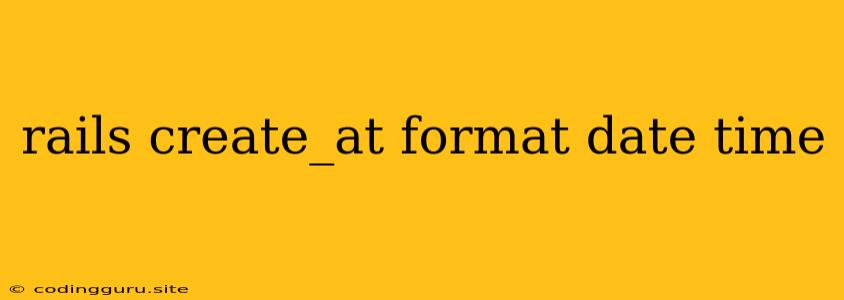Understanding and Formatting created_at in Rails
Rails is a powerful framework for building web applications, and it offers a lot of functionalities that make development easier. One of these functionalities is the automatic creation of created_at and updated_at timestamps for your models. These timestamps are crucial for tracking changes in your data and can be very useful for various purposes, like auditing, data analysis, or simply providing information to users.
However, the default format of these timestamps might not always be what you need. You might want to display the date in a more user-friendly way, or maybe you only need the time portion. This is where formatting comes into play. In this article, we'll explore how you can format the created_at timestamp in your Rails application.
What is created_at?
created_at is a timestamp that Rails automatically adds to your database records. It represents the moment when a record was created. This information is useful for:
- Tracking Changes: You can see when a record was created, helping you understand its history.
- Auditing: You can use
created_atto see who created a record or when specific actions were taken. - Data Analysis: You can analyze your data based on the
created_attimestamp, for example, grouping data by creation date or determining the most recent entries.
How to Format created_at in Rails
There are multiple ways to format the created_at timestamp in Rails. Here are some of the most common methods:
1. Using the strftime method
The strftime method is a standard Ruby method that lets you format dates and times according to specific patterns. You can use it in your views or controllers to display the created_at timestamp in the desired format.
Example:
# In your view
<%= @post.created_at.strftime("%B %d, %Y") %>
# Output: October 26, 2023
Common format codes:
- %B: Full month name (e.g., January, February)
- %d: Day of the month (01-31)
- %Y: Year with century (e.g., 2023)
- %H: Hour (00-23)
- %M: Minute (00-59)
- %S: Second (00-59)
2. Using to_formatted_s method
The to_formatted_s method is a convenience method provided by Rails that allows you to format the created_at timestamp based on the current locale settings.
Example:
# In your view
<%= @post.created_at.to_formatted_s(:long) %>
# Output: October 26, 2023 at 10:45:00 AM (assuming your locale is set to English)
Different format options:
:long: Full date and time (e.g., October 26, 2023 at 10:45:00 AM):short: Short date and time (e.g., 10/26/2023 10:45 AM):rfc822: RFC 822 formatted time (e.g., Thu, 26 Oct 2023 10:45:00 +0000):iso8601: ISO 8601 formatted time (e.g., 2023-10-26T10:45:00+00:00)
3. Using I18n for Localization
You can use I18n to format the created_at timestamp according to your application's locale settings.
Example:
# In your view
<%= I18n.l(@post.created_at, format: :long) %>
# Output: October 26, 2023 at 10:45:00 AM (assuming your locale is set to English)
Benefits of using I18n:
- Localization: Your application can display dates and times in the format expected by users in different regions.
- Consistency: You can define standard date and time formats for your application.
4. Using helper methods
Rails provides several helper methods that can be used to format dates and times. You can leverage these methods for cleaner code and improved readability.
Example:
# In your view
<%= time_ago_in_words(@post.created_at) %>
# Output: "about 5 hours ago" (assuming the post was created 5 hours ago)
Other helper methods:
distance_of_time_in_words: Displays the time difference in words.distance_of_time_in_words_to_now: Calculates the time difference from now.
Conclusion
Formatting the created_at timestamp in Rails is a common task that involves understanding the different options available and choosing the best method for your specific needs. Whether you want to display a simple date, a full date and time, or a localized time, Rails provides several tools to help you achieve the desired outcome. Remember to choose the approach that best suits your application's requirements and ensures a user-friendly and informative experience for your users.
